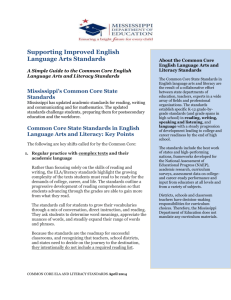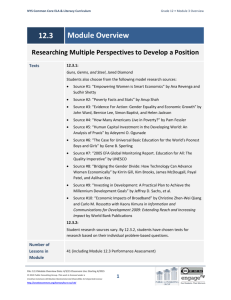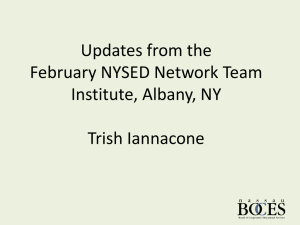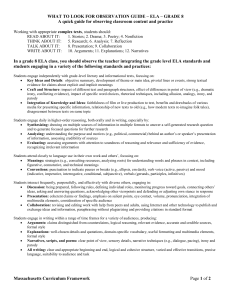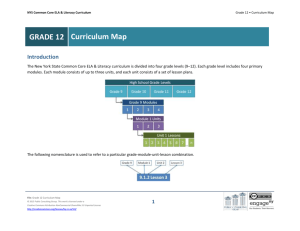Texts - EngageNY
advertisement
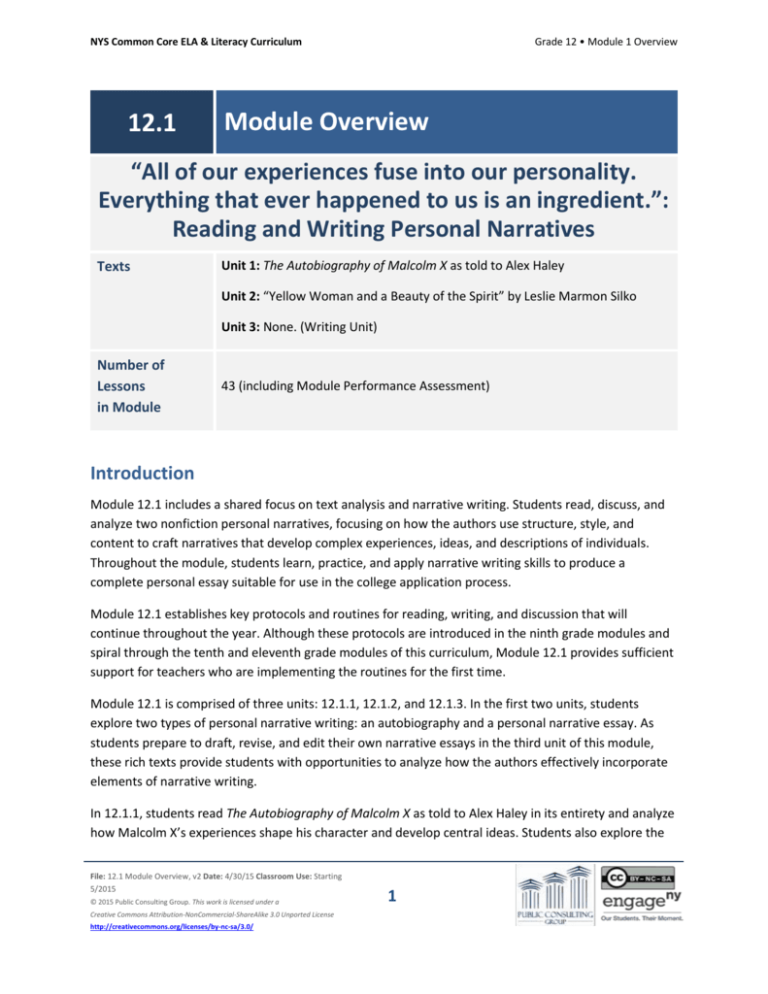
NYS Common Core ELA & Literacy Curriculum 12.1 Grade 12 • Module 1 Overview Module Overview “All of our experiences fuse into our personality. Everything that ever happened to us is an ingredient.”: Reading and Writing Personal Narratives Texts Unit 1: The Autobiography of Malcolm X as told to Alex Haley Unit 2: “Yellow Woman and a Beauty of the Spirit” by Leslie Marmon Silko Unit 3: None. (Writing Unit) Number of Lessons in Module 43 (including Module Performance Assessment) Introduction Module 12.1 includes a shared focus on text analysis and narrative writing. Students read, discuss, and analyze two nonfiction personal narratives, focusing on how the authors use structure, style, and content to craft narratives that develop complex experiences, ideas, and descriptions of individuals. Throughout the module, students learn, practice, and apply narrative writing skills to produce a complete personal essay suitable for use in the college application process. Module 12.1 establishes key protocols and routines for reading, writing, and discussion that will continue throughout the year. Although these protocols are introduced in the ninth grade modules and spiral through the tenth and eleventh grade modules of this curriculum, Module 12.1 provides sufficient support for teachers who are implementing the routines for the first time. Module 12.1 is comprised of three units: 12.1.1, 12.1.2, and 12.1.3. In the first two units, students explore two types of personal narrative writing: an autobiography and a personal narrative essay. As students prepare to draft, revise, and edit their own narrative essays in the third unit of this module, these rich texts provide students with opportunities to analyze how the authors effectively incorporate elements of narrative writing. In 12.1.1, students read The Autobiography of Malcolm X as told to Alex Haley in its entirety and analyze how Malcolm X’s experiences shape his character and develop central ideas. Students also explore the File: 12.1 Module Overview, v2 Date: 4/30/15 Classroom Use: Starting 5/2015 © 2015 Public Consulting Group. This work is licensed under a Creative Commons Attribution-NonCommercial-ShareAlike 3.0 Unported License http://creativecommons.org/licenses/by-nc-sa/3.0/ 1 NYS Common Core ELA & Literacy Curriculum Grade 12 • Module 1 Overview structure of the narrative and how style and content contribute to the text’s power and beauty. Throughout the unit, students examine the narrative elements of the text and practice using components of narrative writing in a personal essay. In 12.1.2, students examine Silko’s personal narrative essay, “Yellow Woman and a Beauty of the Spirit,” and focus on how the author uses structure and language to build and refine complex ideas. As in the first unit, students continue to analyze how the author uses elements of narrative writing to effectively structure her personal exploration of the way meaningful experiences and cultural history have influenced her identity formation. In the final unit, 12.1.3, students concentrate on the narrative writing process, building on the material they produced during the writing lessons of 12.1.1 and incorporating a variety of narrative techniques explored in both 12.1.1 and 12.1.2. Students draft, revise, and edit their essays extensively over the course of the unit, further developing their narrative writing skills through peer-review and discussions. At the end of this unit, students produce a final draft of their personal narrative. Throughout the module, students’ engagement with personal narratives through text-analysis, independent writing, and interview practice prepares them for the Module Performance Assessment, in which students respond orally to sample questions that may be asked during the college interview process. Literacy Skills & Habits Read closely for textual details Annotate texts to support comprehension and analysis Engage in productive evidence-based discussions about texts Collect and organize evidence from texts to support analysis in writing Make claims about texts using specific textual evidence Use vocabulary strategies to define unknown words Paraphrase and quote relevant evidence from texts Independently preview texts in preparation for supported analysis Independently develop questions for further textual analysis Write narratives to develop real or imagined experiences or events Produce writing that is appropriate to task, purpose, and audience Independently practice the writing process outside of class Use rubrics and checklists for self-assessment and peer review of writing File: 12.1 Module Overview, v2 Date: 4/30/15 Classroom Use: Starting 5/2015 © 2015 Public Consulting Group. This work is licensed under a Creative Commons Attribution-NonCommercial-ShareAlike 3.0 Unported License http://creativecommons.org/licenses/by-nc-sa/3.0/ 2 NYS Common Core ELA & Literacy Curriculum Grade 12 • Module 1 Overview Practice speaking and listening skills in preparation for a college interview English Language Arts Outcomes Yearlong Target Standards These standards embody the pedagogical shifts required by the Common Core State Standards and will be a strong focus in every English Language Arts module and unit in grades 9–12. CCS Standards: Reading—Literature RL.11-12.1 Cite strong and thorough textual evidence to support analysis of what the text says explicitly as well as inferences drawn from the text, including determining where the text leaves matters uncertain. RL.11-12.4 Determine the meaning of words and phrases as they are used in the text, including figurative and connotative meanings; analyze the impact of specific word choices on meaning and tone, including words with multiple meanings or language that is particularly fresh, engaging, or beautiful. (Include Shakespeare as well as other authors.) RL.11-12.10 By the end of grade 11, read and comprehend literature, including stories, dramas, and poems, in the grades 11–CCR text complexity band proficiently, with scaffolding as needed at the high end of the range. CCS Standards: Reading—Informational Text RI.11-12.1.a Cite strong and thorough textual evidence to support analysis of what the text says explicitly as well as inferences drawn from the text, including determining where the text leaves matters uncertain. a. Develop factual, interpretive, and evaluative questions for further exploration of the topic(s). RI.11-12.4 Determine the meaning of words and phrases as they are used in a text, including figurative, connotative, and technical meanings; analyze how an author uses and refines the meaning of a key term or terms over the course of a text (e.g., how Madison defines faction in Federalist No. 10). RI.11-12.10 By the end of grade 12, read and comprehend literary nonfiction at the high end of the grades 11–CCR text complexity band independently and proficiently. File: 12.1 Module Overview, v2 Date: 4/30/15 Classroom Use: Starting 5/2015 © 2015 Public Consulting Group. This work is licensed under a Creative Commons Attribution-NonCommercial-ShareAlike 3.0 Unported License http://creativecommons.org/licenses/by-nc-sa/3.0/ 3 NYS Common Core ELA & Literacy Curriculum Grade 12 • Module 1 Overview CCS Standards: Writing W.11-12.9.a, Draw evidence from literary or informational texts to support analysis, reflection, and b research. a. Apply grades 11–12 Reading standards to literature (e.g., “Demonstrate knowledge of eighteenth-, nineteenth- and early-twentieth-century foundational works of American literature, including how two or more texts from the same period treat similar themes or topics”). b. Apply grades 11–12 Reading standards to literary nonfiction (e.g., “Delineate and evaluate the reasoning in seminal U.S. texts, including the application of constitutional principles and use of legal reasoning [e.g., in U.S. Supreme Court Case majority opinions and dissents] and the premises, purposes, and arguments in works of public advocacy [e.g., The Federalist, presidential addresses]”). W.11-12.10 Write routinely over extended time frames (time for research, reflection, and revision) and shorter time frames (a single sitting or a day or two) for a range of tasks, purposes, and audiences. CCS Standards: Speaking & Listening SL.11-12.1 Initiate and participate effectively in a range of collaborative discussions (one-on-one, in groups, and teacher-led) with diverse partners on grades 11–12 topics, texts, and issues, building on others’ ideas and expressing their own clearly and persuasively. CCS Standards: Language L.11-12.4.ad Determine or clarify the meaning of unknown and multiple-meaning words and phrases based on grades 11–12 reading and content, choosing flexibly from a range of strategies. a. Use context (e.g., the overall meaning of a sentence, paragraph, or text; a word’s position or function in a sentence) as a clue to the meaning of a word or phrase. b. Identify and correctly use patterns of word changes that indicate different meanings or parts of speech (e.g., conceive, conception, conceivable). c. Consult general and specialized reference materials (e.g., dictionaries, glossaries, thesauruses), both print and digital, to find the pronunciation of a word or determine or clarify its precise meaning, its part of speech, its etymology, or its standard usage. d. Verify the preliminary determination of the meaning of a word or phrase (e.g., by checking the inferred meaning in context or in a dictionary). File: 12.1 Module Overview, v2 Date: 4/30/15 Classroom Use: Starting 5/2015 © 2015 Public Consulting Group. This work is licensed under a Creative Commons Attribution-NonCommercial-ShareAlike 3.0 Unported License http://creativecommons.org/licenses/by-nc-sa/3.0/ 4 NYS Common Core ELA & Literacy Curriculum Grade 12 • Module 1 Overview Module-Specific Assessed Standards These standards will be the specific focus of instruction and assessment, based on the texts studied and proficiencies developed in this module. College and Career Readiness Anchor Standards for Reading None. CCS Standards: Reading—Literature None. CCS Standards: Reading—Informational Text RI.11-12.2 Determine two or more central ideas of a text and analyze their development over the course of the text, including how they interact and build on one another to provide a complex analysis; provide an objective summary of the text. RI.11-12.3 Analyze a complex set of ideas or sequence of events and explain how specific individuals, ideas, or events interact and develop over the course of the text. RI.11-12.4 Determine the meaning of words and phrases as they are used in a text, including figurative, connotative, and technical meanings; analyze how an author uses and refines the meaning of a key term or terms over the course of a text (e.g., how Madison defines faction in Federalist No. 10). RI.11-12.5 Analyze and evaluate the effectiveness of the structure an author uses in his or her exposition or argument, including whether the structure makes points clear, convincing, and engaging. RI.11-12.6 Determine an author’s point of view or purpose in a text in which the rhetoric is particularly effective, analyzing how style and content contribute to the power, persuasiveness, or beauty of the text. CCS Standards: Writing W.11-12.2.af Write informative/explanatory texts to examine and convey complex ideas, concepts, and information clearly and accurately through the effective selection, organization, and analysis of content. a. Introduce a topic; organize complex ideas, concepts, and information so that each new element builds on that which precedes it to create a unified whole; include formatting (e.g., headings), graphics (e.g., figures, tables), and multimedia when useful to aiding comprehension. b. Develop the topic thoroughly by selecting the most significant and relevant facts, extended definitions, concrete details, quotations, or other information and examples appropriate to the audience’s knowledge of the topic. c. Use appropriate and varied transitions and syntax to link the major sections of the File: 12.1 Module Overview, v2 Date: 4/30/15 Classroom Use: Starting 5/2015 © 2015 Public Consulting Group. This work is licensed under a Creative Commons Attribution-NonCommercial-ShareAlike 3.0 Unported License http://creativecommons.org/licenses/by-nc-sa/3.0/ 5 NYS Common Core ELA & Literacy Curriculum Grade 12 • Module 1 Overview text, create cohesion, and clarify the relationships among complex ideas and concepts. d. Use precise language, domain-specific vocabulary, and techniques such as metaphor, simile, and analogy to manage the complexity of the topic. e. Establish and maintain a formal style and objective tone while attending to the norms and conventions of the discipline in which they are writing. f. W.11-12.3.af Provide a concluding statement or section that follows from and supports the information or explanation presented (e.g., articulating implications or the significance of the topic). Write narratives to develop real or imagined experiences or events using effective technique, well-chosen details, and well-structured event sequences. a. Engage and orient the reader by setting out a problem, situation, or observation and its significance, establishing one or multiple point(s) of view, and introducing a narrator and/or characters; create a smooth progression of experiences or events. b. Use narrative techniques, such as dialogue, pacing, description, reflection, and multiple plot lines, to develop experiences, events, and/or characters. c. Use a variety of techniques to sequence events so that they build on one another to create a coherent whole and build toward a particular tone and outcome (e.g., a sense of mystery, suspense, growth, or resolution). d. Use precise words and phrases, telling details, and sensory language to convey a vivid picture of the experiences, events, setting, and/or characters. e. Provide a conclusion that follows from and reflects on what is experienced, observed, or resolved over the course of the narrative. f. Adapt voice, awareness of audience, and use of language to accommodate a variety of cultural contexts. W.11-12.4 Produce clear and coherent writing in which the development, organization, and style are appropriate to task, purpose, and audience. W.11-12.5 Develop and strengthen writing as needed by planning, revising, editing, rewriting, or trying a new approach, focusing on addressing what is most significant for a specific purpose and audience. W.11-12.9.b Draw evidence from literary or informational texts to support analysis, reflection, and research. b. Apply grades 11–12 Reading standards to literary nonfiction (e.g., “Delineate and evaluate the reasoning in seminal U.S. texts, including the application of constitutional principles and use of legal reasoning [e.g., in U.S. Supreme Court Case majority opinions and dissents] and the premises, purposes, and arguments File: 12.1 Module Overview, v2 Date: 4/30/15 Classroom Use: Starting 5/2015 © 2015 Public Consulting Group. This work is licensed under a Creative Commons Attribution-NonCommercial-ShareAlike 3.0 Unported License http://creativecommons.org/licenses/by-nc-sa/3.0/ 6 NYS Common Core ELA & Literacy Curriculum Grade 12 • Module 1 Overview in works of public advocacy [e.g., The Federalist, presidential addresses]”). CCS Standards: Speaking & Listening SL.11-12.4 Present information, findings, and supporting evidence, conveying a clear and distinct perspective, such that listeners can follow the line of reasoning, alternative or opposing perspectives are addressed, and the organization, development, substance, and style are appropriate to purpose, audience, and a range of formal and informal tasks. SL.11-12.6 Adapt speech to a variety of contexts and tasks, demonstrating a command of formal English when indicated or appropriate. (See grades 11–12 Language standards 1 and 3 for specific expectations.) CCS Standards: Language L.11-12.1 Demonstrate command of the conventions of standard English grammar and usage when writing or speaking. L.11-12.2.a, b Demonstrate command of the conventions of standard English capitalization, punctuation, and spelling when writing. a. Observe hyphenation conventions. b. Spell correctly. L.11-12.4.ac Determine or clarify the meaning of unknown and multiple-meaning words and phrases based on grades 11–12 reading and content, choosing flexibly from a range of strategies. a. Use context (e.g., the overall meaning of a sentence, paragraph, or text; a word’s position or function in a sentence) as a clue to the meaning of a word or phrase. b. Identify and correctly use patterns of word changes that indicate different meanings or parts of speech (e.g., conceive, conception, conceivable). c. Consult general and specialized reference materials (e.g., dictionaries, glossaries, thesauruses), both print and digital, to find the pronunciation of a word or determine or clarify its precise meaning, its part of speech, its etymology, or its standard usage. Addressed Standards These standards will be addressed at the unit or module level, and may be considered in assessment, but will not be the focus of extended instruction in this module. File: 12.1 Module Overview, v2 Date: 4/30/15 Classroom Use: Starting 5/2015 © 2015 Public Consulting Group. This work is licensed under a Creative Commons Attribution-NonCommercial-ShareAlike 3.0 Unported License http://creativecommons.org/licenses/by-nc-sa/3.0/ 7 NYS Common Core ELA & Literacy Curriculum Grade 12 • Module 1 Overview College and Career Readiness Anchor Standards for Reading None. CCS Standards: Reading – Literature None. CCS Standards: Reading – Informational Text RI.11-12.1 Cite strong and thorough textual evidence to support analysis of what the text says explicitly as well as inferences drawn from the text, including determining where the text leaves matters uncertain. CCS Standards: Writing W.11-12.6 Use technology, including the Internet, to produce, publish, and update individual or shared writing products in response to ongoing feedback, including new arguments or information. CCS Standards: Speaking & Listening SL.11-12.1.ac Initiate and participate effectively in a range of collaborative discussions (one-on-one, in groups, and teacher-led) with diverse partners on grades 11–12 topics, texts, and issues, building on others’ ideas and expressing their own clearly and persuasively. a. Come to discussions prepared, having read and researched material under study; explicitly draw on that preparation by referring to evidence from texts and other research on the topic or issue to stimulate a thoughtful, well-reasoned exchange of ideas. b. Work with peers to promote civil, democratic discussions and decision-making, set clear goals and deadlines, and establish individual roles as needed. c. Propel conversations by posing and responding to questions that probe reasoning and evidence; ensure a hearing for a full range of positions on a topic or issue; clarify, verify, or challenge ideas and conclusions; and promote divergent and creative perspectives. CCS Standards: Language L.11-12.3 Apply knowledge of language to understand how language functions in different contexts, to make effective choices for meaning or style, and to comprehend more fully when reading or listening. L.11-12.5.a Demonstrate understanding of figurative language, word relationships, and nuances in word meanings. a. Interpret figures of speech (e.g., hyperbole, paradox) in context and analyze their role in the text. File: 12.1 Module Overview, v2 Date: 4/30/15 Classroom Use: Starting 5/2015 © 2015 Public Consulting Group. This work is licensed under a Creative Commons Attribution-NonCommercial-ShareAlike 3.0 Unported License http://creativecommons.org/licenses/by-nc-sa/3.0/ 8 NYS Common Core ELA & Literacy Curriculum Grade 12 • Module 1 Overview Module Performance Assessment Prompt In this two-lesson Performance Assessment, students work in peer groups to practice responding orally to a series of questions that colleges may ask during an interview, and students assess their peers on several aspects of their answers including the organization, development, substance, and style of their responses. Students take their peers’ feedback into account to prepare for the culminating assessment: a fishbowl activity in which students respond orally to one of the questions they have practiced and are assessed on their response. Interview Questions: What three adjectives best describe you? What are your strengths and weaknesses? What activities do you find most rewarding? What is your favorite book? What do you want to do after graduating from college? What do you expect to be doing ten years from now? Why do you want to attend our college? What can you contribute to our college campus? Lesson 1 In Lesson 1, students work in small groups to practice answering the sample interview questions. One at a time, each student draws an index card and orally answers the question, while the peers listen and then complete a 12.1 Peer Feedback Checklist for each student. This process repeats until as many questions as possible are answered completely, but each student should answer at least 2 questions fully. Students may then share feedback verbally, as well as provide each student his or her 12.1 Peer Feedback Checklists for review. Lesson 2 In Lesson 2, students come to class prepared to respond to any of the interview questions. Students arrange their desks in a fishbowl format with 3–4 desks in the center of the class and the others arranged in a circle around them. Groups of 3–4 students are called to the center. The teacher asks each student one of the eight interview questions and assesses students’ responses. File: 12.1 Module Overview, v2 Date: 4/30/15 Classroom Use: Starting 5/2015 © 2015 Public Consulting Group. This work is licensed under a Creative Commons Attribution-NonCommercial-ShareAlike 3.0 Unported License http://creativecommons.org/licenses/by-nc-sa/3.0/ 9 NYS Common Core ELA & Literacy Curriculum Grade 12 • Module 1 Overview Texts Unit 1: “I’m for truth, no matter who tells it” X, Malcolm and Alex Haley. The Autobiography of Malcolm X as told to Alex Haley. New York: Ballantine Books, 1999. Unit 2: “Remember the stories, the stories will help you be strong” Silko, Leslie Marmon. “Yellow Woman and a Beauty of the Spirit.” Yellow Woman and a Beauty of the Spirit. Pages 10–15. http://www.uidaho.edu/. Unit 3: Crafting a Personal Narrative Essay None. Module-at-a-Glance Calendar Text Lessons in the Unit Literacy Skills and Habits Assessed and Addressed CCSS Assessments Unit 1: “I’m for truth, no matter who tells it” The Autobiography of Malcolm X as told to Alex Haley 28 Read closely for textual details Annotate texts to support comprehension and analysis Analyze the impact of style and content on the text Engage in productive evidence-based discussions about text Collect and organize evidence from texts to support analysis in writing Independently read and annotate text in preparation for evidence-based File: 12.1 Module Overview, v2 Date: 4/30/15 Classroom Use: Starting 5/2015 © 2015 Public Consulting Group. This work is licensed under a Creative Commons Attribution-NonCommercial-ShareAlike 3.0 Unported License http://creativecommons.org/licenses/by-nc-sa/3.0/ 10 RI.11-12.1 RI.11-12.2 RI.11-12.3 RI.11-12.4 RI.11-12.5 RI.11-12.6 W.11-12.2.a-f W.11-12.3.a-e W.11-12.3.f W.11-12.4 W.11-12.5 W.11-12.9.b SL.11-12.1.a-c SL.11-12.4 SL.11-12.6 L.11-12.1 L.11-12.2.b L.11-12.3 L.11-12.4.a-c L.11-12.5.a Mid-Unit: Students write a multiparagraph response to the following prompt: Determine the author’s purpose and analyze how theCen structure, style, and content contribute to the power or beauty of the text. End-of-Unit: Students write a multiparagraph response to the following prompt: Analyze how three key events in The Autobiography of Malcolm X interact to develop one or more NYS Common Core ELA & Literacy Curriculum Text Lessons in the Unit Grade 12 • Module 1 Overview Literacy Skills and Habits discussion Make claims about texts using specific textual evidence Use vocabulary strategies to define unknown words Write informative texts to convey complex ideas. Write narratives to develop real or imagined experiences or events Independently practice the writing process outside of class Practice speaking and listening skills in preparation for a college interview. Assessed and Addressed CCSS Assessments central ideas in the text. Unit 2: “Remember the stories, the stories will help you be strong” “Yellow Woman and a Beauty of the Spirit” by Leslie Marmon Silko 6 Read closely for textual details Annotate texts to support comprehension and analysis Engage in productive evidence-based discussions about the text Collect and organize evidence from texts to File: 12.1 Module Overview, v2 Date: 4/30/15 Classroom Use: Starting 5/2015 © 2015 Public Consulting Group. This work is licensed under a Creative Commons Attribution-NonCommercial-ShareAlike 3.0 Unported License http://creativecommons.org/licenses/by-nc-sa/3.0/ 11 RI.11-12.2 RI.11-12.3 RI.11-12.4 RI.11-12.5 W.11-12.2.a-f W.11-12.3.a-f W.11-12.9.b L.11-12.1 L.11-12.2.b L.11-12.4.a,b End-of-Unit: Students write a multiparagraph response to the following prompt: Analyze the effectiveness of the structure Silko uses in her exposition, including whether the structure makes points clear, convincing, and NYS Common Core ELA & Literacy Curriculum Text Lessons in the Unit Grade 12 • Module 1 Overview Literacy Skills and Habits support analysis in writing Make claims about texts using specific textual evidence Use vocabulary strategies to define unknown words Trace the development of ideas over the course of the text Examine the use and refinement of a key term over the course of the text Practice speaking and listening skills in preparation for a college interview Assessed and Addressed CCSS Assessments engaging. Unit 3: Crafting a Personal Narrative Essay None. 7 Write an effective introduction to a narrative essay W.11-12.3.a-f W.11-12.4 W.11-12.5 W.11-12.6 Write an effective conclusion to a narrative SL.11-12.4 SL.11-12.6 essay L.11-12.1 Incorporate a range of L.11-12.2.a,b narrative techniques, such as dialogue, pacing, description, and reflection Sequence events so that they build on one File: 12.1 Module Overview, v2 Date: 4/30/15 Classroom Use: Starting 5/2015 © 2015 Public Consulting Group. This work is licensed under a Creative Commons Attribution-NonCommercial-ShareAlike 3.0 Unported License http://creativecommons.org/licenses/by-nc-sa/3.0/ 12 End-of-Unit: Students complete the final drafts of their narrative essays. NYS Common Core ELA & Literacy Curriculum Text Lessons in the Unit Grade 12 • Module 1 Overview Literacy Skills and Habits another to create a whole and build toward a particular tone and outcome (e.g., a sense of mystery, suspense, growth, or resolution) Use precise words and phrases, telling details, and sensory language Engage in constructive peer-review of narrative essays Produce writing that is appropriate to task, purpose, and audience. Practice speaking and listening skills in preparation for a college interview Assessed and Addressed CCSS Note: Bold text indicates targeted standards that will be assessed in the module. File: 12.1 Module Overview, v2 Date: 4/30/15 Classroom Use: Starting 5/2015 © 2015 Public Consulting Group. This work is licensed under a Creative Commons Attribution-NonCommercial-ShareAlike 3.0 Unported License http://creativecommons.org/licenses/by-nc-sa/3.0/ 13 Assessments

